Defence Technology – Missiles, Submarines, UAVs | Science & Technology for UPSC CSE PDF Download
Ballistic Missile and Cruise Missile
The terms 'ballistic missile' and 'cruise missile' are commonly mentioned in news articles related to missile tests and are crucial to understanding various Indian missile defense systems.
Ballistic Missile
- A ballistic missile is designed to follow a ballistic trajectory as it delivers one or more warheads to a predetermined target. A ballistic trajectory refers to the path of an object that is launched into the air but lacks active propulsion during its flight.
- These missiles are guided only during specific phases of their flight. The trajectory of a ballistic missile is determined primarily by its initial velocity, the effects of gravity, air resistance, and the Earth's motion (Coriolis Force).
- Shorter-range ballistic missiles remain within the Earth's atmosphere for their entire flight. Longer-ranged intercontinental ballistic missiles (ICBMs) are launched on a sub-orbital flight trajectory and spend most of their journey outside the Earth's atmosphere.
Types of ballistic missiles based on the range
- Short-range (tactical) ballistic missile (SRBM): Range between 300 km and 1,000 km.
- Medium-range (theatre) ballistic missile (MRBM): 1,000 km to 3,500 km.
- Intermediate-range (Long-Range) ballistic missile (IRBM or LRBM): 3,500 km and 5,500 km.
- Intercontinental ballistic missile (ICBM): 5,500 km +
Cruise Missile
- A cruise missile is a guided missile used to target terrestrial (land-based) objectives.
- Unlike ballistic missiles, cruise missiles remain within the Earth's atmosphere for the entirety of their flight.
- Cruise missiles typically maintain a relatively constant speed throughout their flight.
- These missiles are specifically designed to deliver a sizable warhead to distant targets with exceptional accuracy.
- Modern cruise missiles have advanced capabilities, including supersonic or high subsonic speeds, self-navigation systems, and the ability to follow a non-ballistic, very low-altitude flight path.
Types of cruise missiles based on speed
- Hypersonic (Mach 5): these missiles would travel at least five times the speed of sound (Mach 5). E.g. BrahMos-II.
- Supersonic (Mach 2-3): these missiles travel faster than the speed of sound. E.g. BrahMos.
- Subsonic (Mach 0.8): these missiles travel slower than the speed of sound. E.g. Nirbhay.
Differences between Ballistic Missile and Cruise Missile
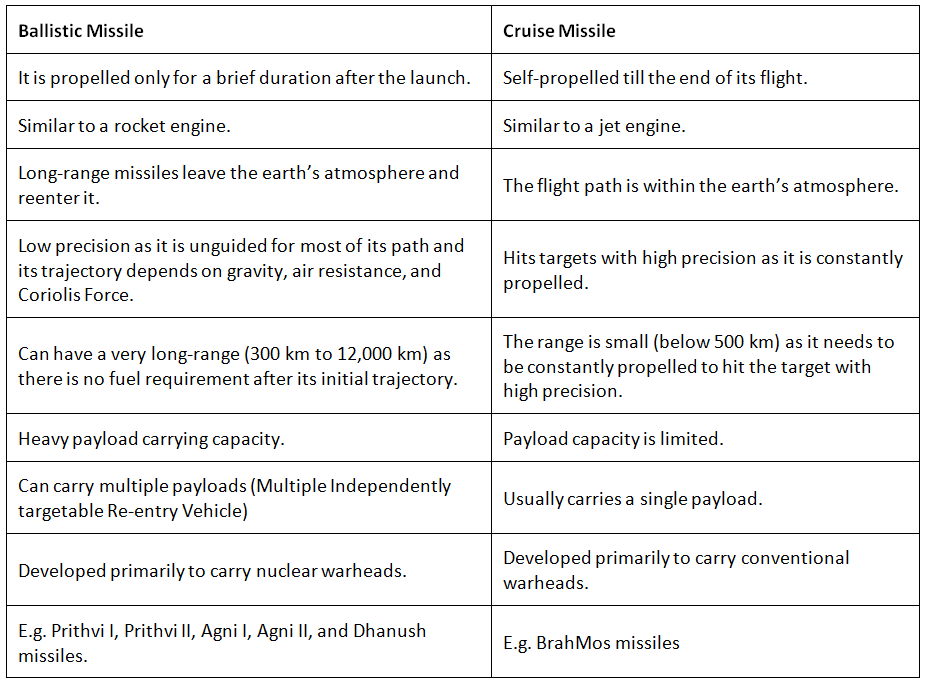
Air to Air Missile (AAM)
An Air to Air Missile (AAM) is a missile that is launched from an aircraft with the intention of destroying another aircraft or any airborne target.
AAMs are broadly categorized into two types based on their range capabilities:
- Short Range Air to Air Missile (SRAAM) or Within Visual Range Air to Air Missile (WVRAAM): These missiles are designed for engaging aerial targets within a range of up to 30 kilometers. Most SRAAMs utilize infrared guidance systems, making them heat-seeking missiles. They are engineered for enhanced agility and are often referred to as dogfight missiles.
- Beyond Visual Range Air to Air Missile (BVRAAM): These missiles are capable of hitting targets at distances beyond 37 kilometers. BVRAAMs rely on radar guidance systems instead of infrared detectors, as the infrared signatures of aerial targets become too weak at longer ranges.
Astra is an example of a Beyond Visual Range Air to Air Missile (BVRAAM) developed by the Defence Research and Development Organisation (DRDO). It possesses the capability to engage aerial targets at a range extending from 80 kilometers to 110 kilometers. Astra has been successfully integrated into various fighter aircraft, including the Sukhoi 30 Mki, Mirage 2000, Light Combat Aircraft (LCA), and MiG-29.
India’s Missile Systems

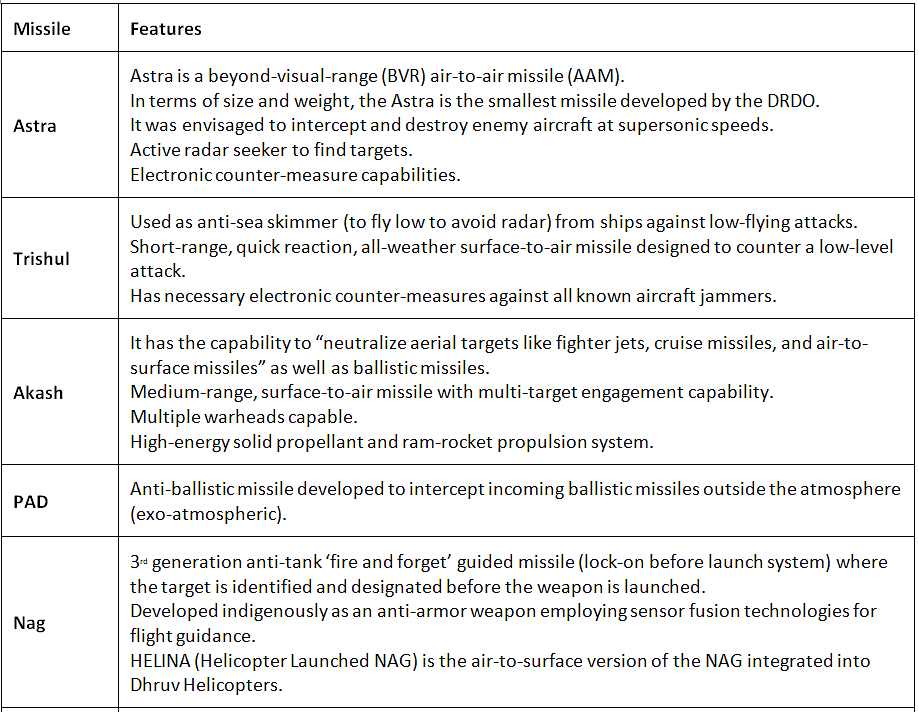
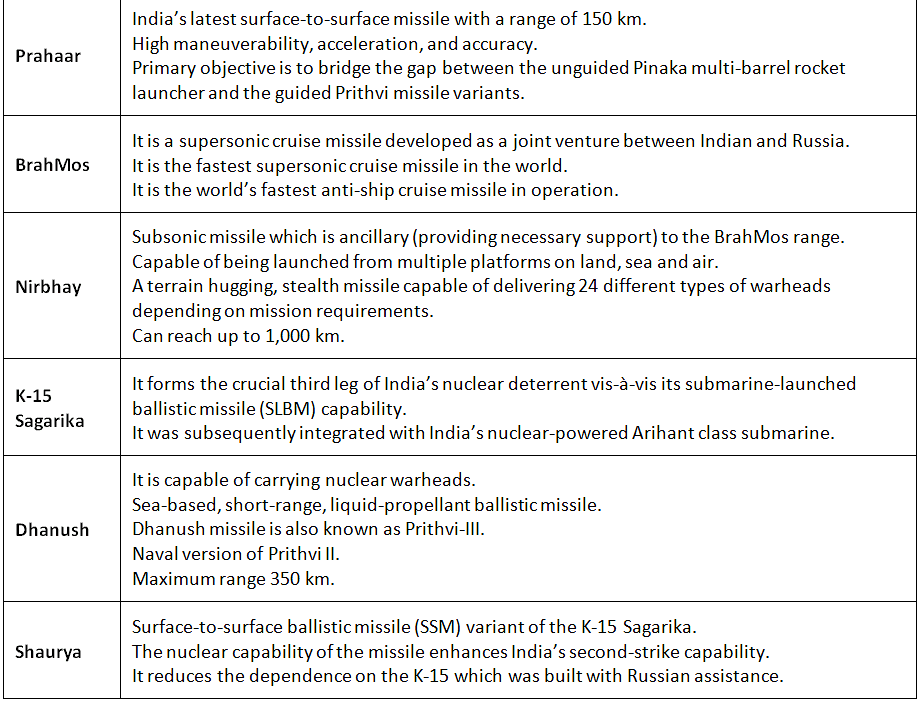
Prithvi Missiles
All the Prithvi variants are surface-to-surface SRBMs (short-range ballistic missile).
Agni Missiles
 MIRV: Multiple Independently targetable Re-entry Vehicle
MIRV: Multiple Independently targetable Re-entry Vehicle
Anti-satellite weapons (ASAT)
- In March 2019, India successfully tested its ASAT missile.
- The ASAT missile destroyed a live satellite in Low Earth orbit (283-kilometre).
- As per DRDO, the missile is capable of shooting down targets moving at a speed of 10 km per second at an altitude as high as 1200 km.
Integrated Guided Missile Development Program(IGMDP)
The Integrated Guided Missile Development Program (IGMDP) was conceived by the eminent scientist Dr. APJ Abdul Kalam with the primary objective of achieving self-sufficiency in the field of missile technology. Recognizing the diverse requirements of the defense forces for various types of missiles, the program aimed to develop five distinct missile systems.
The Indian government officially approved the IGMDP on July 26, 1983, marking a significant milestone. The program fostered collaboration among the nation's scientific community, academic institutions, research and development (R&D) laboratories, industries, and all three branches of the defense services to realize indigenous missile systems with strategic importance.
The missile systems developed as part of the IGMDP include:
- Prithvi - A short-range surface-to-surface ballistic missile.
- Agni - An intermediate-range surface-to-surface ballistic missile.
- Trishul - A short-range low-level surface-to-air missile.
- Akash - A medium-range surface-to-air missile.
- Nag - A third-generation anti-tank missile.
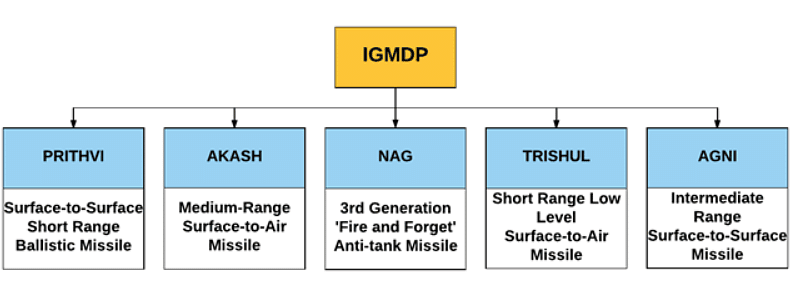
Agni I
- Type: Medium Range Ballistic Missile (MRBM)
- Propulsion: Single-stage solid fuel with a liquid propulsion upper stage
- Range: 700-800 km
Agni II
- Type: Intermediate-Range Ballistic Missile (IRBM)
- Range: More than 2,000 km
Agni III
- Type: Two-stage IRBM
- Features: Supports a variety of warhead configurations
- Range: More than 2,500 km
Agni IV
- Type: Two-stage solid-fueled missile
- Features: Road-mobile launcher, equipped with ring laser gyro and composite rocket motor
- Range: More than 3,500 km
Agni V
- Type: Three-stage solid-fueled Inter-Continental Ballistic Missile (ICBM)
- Features: Can carry 1.5-tonne nuclear warheads, canister launch system
- Range: More than 5,000 km
- Note: Puts India in an exclusive club of ICBM-capable nations.
Prithvi
- Type: Surface-to-surface battlefield missile
- Features: Can accommodate various interchangeable warheads
- Range: 150 km to 300 km
BrahMos
- Type: Supersonic cruise missile
- Features: Can be launched from submarines, ships, aircraft, or land
- Range: Originally 300 km, extended to 450-600 km after India's entry into MTCR
- Manufacturer: BrahMos Aerospace Limited, a joint venture between India and Russia
- Speed: One of the world's fastest supersonic cruise missiles (Mach 2.5 - 2.8)
- Weight on Su-30 MKI aircraft: 2.5 tonnes
- Guidance: "Fire and forget" capability, requiring no further guidance after target assignment.
Pralay
- Type: Surface-to-surface tactical missile.
- Origin: Developed by the Defence Research and Development Organisation (DRDO).
- Trial Postponed: The missile's trial was recently postponed due to Cyclone Phethai.
- Derivative: Derived from the Prithvi Defence Vehicle (PDV) exo-atmospheric interceptor, designed to destroy enemy weapons at high altitudes.
- Payload: Capable of carrying a 1-tonne payload.
- Range: Pralay can strike targets up to 350 km away, or up to 500 km if the payload is reduced.
- Propulsion: Powered by a solid-fuel rocket.
- Speed: Faster than conventional missiles in its class, and can potentially evade ballistic missile defense systems.
- Launcher: It will be launched from its own canister-based transport erector launcher.
Quick Reaction Surface-to-Air missiles (QRSAM)
DRDO has successfully test-fired indigenously developed Quick Reaction Surface-to-Air missiles (QRSAM) from a test range off the Odisha coast.
It has been developed to replace the ‘Akash’ missile defence system, and has 360-degree coverage.
Key Features
- Development: Indigenously developed by DRDO.
- Purpose: Designed to replace the 'Akash' missile defense system.
- Coverage: Provides 360-degree coverage.
- Propellant: Uses solid fuel propellant.
- Strike Range: Capable of striking targets at a range of 25-30 km and engaging multiple targets.
- Low-Flying Targets: Can intercept low-flying objects.
- All-Weather Capability: Effective in all weather conditions and terrains.
- Counter Measures: Equipped with electronic countermeasures against jamming by aircraft radars.
- Mobility: Can be mounted on a truck and stored in a canister.
- Navigation System: Features a midcourse inertial navigation system with a two-way data link and a DRDO-developed terminal active seeker.
- Compact and Mobile: QRSAM is a compact and mobile weapon system with a fully automated Command and Control System.
- Radar Coverage: Comprises two four-walled radars - the Active Array Battery Surveillance Radar and the Active Array Battery Multifunction Radar - providing 360-degree coverage.
Nuclear and Conventional Submarines
Nuclear Submarines
- Power Source: Nuclear submarines are powered by nuclear reactors modified for underwater use. These reactors generate heat, producing steam that drives turbines connected to a propeller and a generator.
- Unlimited Range: Nuclear submarines have virtually unlimited range due to their nuclear power source. They can stay submerged for months without resurfacing.
- Self-Sufficiency: These submarines have on-board systems for generating oxygen, and they carry a significant supply of food and water. This enables them to operate continuously underwater for up to 90 days.
Conventional Submarines
- Power Source: Conventional diesel submarines rely on diesel engines and electricity. They have a network of batteries that are charged using diesel generators.
- Battery Charging: Conventional submarines need to surface or snorkel to charge their batteries. Snorkeling involves staying just below the water's surface with the periscope and exhaust pipe above water to maintain some level of concealment.
- Stealth and Maneuverability: These submarines have smaller hulls, making them more maneuverable in shallow waters and harder to detect. However, their operational endurance is limited by their battery capacity.
In summary, nuclear submarines have the advantage of extended range and the ability to stay submerged for extended periods, while conventional submarines are smaller, more maneuverable, and well-suited for shallow waters but require periodic resurfacing for battery recharge.
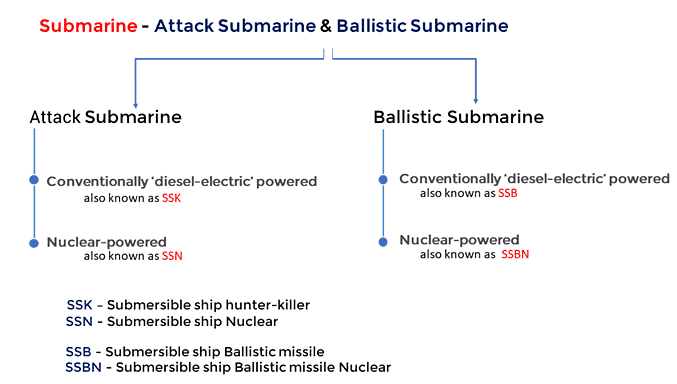
Attack Submarine
- An attack submarine, also known as a hunter-killer submarine, is a type of submarine designed specifically for the purpose of engaging and sinking other submarines, surface combatants (such as warships), and merchant vessels. In the Soviet and Russian navies, these submarines were referred to as "multi-purpose submarines."
- Attack submarines are versatile vessels used not only for offensive operations but also for protecting friendly surface combatants and missile submarines. Some attack submarines are equipped with cruise missiles that are launched from vertical launch tubes, expanding their range of potential missions to include striking land targets. Attack submarines can be powered by either nuclear reactors or conventional diesel-electric engines.
- In the United States Navy and NATO naming systems, nuclear-powered attack submarines are designated as SSNs, while their predecessors with diesel-electric propulsion were known as SSKs. Informally, SSNs in the US Navy are often referred to as "fast attacks."
Ballistic Submarine
- A ballistic missile submarine (SSB or SSBN) is a type of submarine that is specifically designed to carry and launch submarine-launched ballistic missiles (SLBMs) equipped with nuclear warheads. The United States Navy uses the hull classification symbols SSB and SSBN to designate these submarines. The SS signifies "submarine" or "submersible ship," the B indicates "ballistic missile," and the N indicates that the submarine is nuclear-powered.
- Ballistic missile submarines played a significant role in the Cold War due to their nuclear deterrence capabilities. They have the ability to launch missiles over thousands of kilometers, and their acoustic quieting technology makes them difficult to detect, giving them a survivable role in the event of a first strike. They are a critical component of the mutually assured destruction policy of nuclear deterrence.
- The deployment of ballistic missile submarines has been primarily led by the United States and the Soviet Union/Russia, with smaller numbers in service with countries such as France, the United Kingdom, China, and India.
Akula Class Submarines
- The Akula Class Submarine uses a nuclear reactor for propulsion, allowing it to remain underwater for an extended period of time which makes its detection impossible.
- This class of Submarine can be used for multiple tasks like hunting enemy submarines, intelligence surveillance etc.
INS Chakra
- INS Chakra is a Russia-made, nuclear-propelled, hunter-killer akula class submarine.
- INS Chakra is one of the quietest nuclear submarines around, with noise levels next to zero.
- INS Chakra has been taken on lease from Russia for 10 years and would provide the Navy the opportunity to train personnel and operate such nuclear-powered vessels.
- The INS Chakra joined the Eastern Naval Command at Visakhapatnam in 2012.
INS Arihant
- INS Arihant is the first of five nuclear missile submarines planned for induction.
- It is to be equipped with K 15 (or BO-5) shortrange missiles with a range of over 700 km and the K 4 ballistic missile with a range of 3,500 km.
- At present, the only nuclear – powered platform in service is the INS Chakra, a Akula class SSN on lease from Russia.
- The induction of INS Arihant marks the completion of India’s nuclear triad.
- A nuclear triad refers to the nuclear weapons delivery via land, air and sea i.e. land-based intercontinental ballistic missiles (ICBMs), strategic bombers, and submarine-launched ballistic missiles (SLBMs).
INS Kiltan
- It is the indigenously-built anti-submarine warfare stealth corvette.
- It has been recently inducted into the Indian Navy.
- It is the latest indigenous warship after Shivalik Class, Kolkata Class, and sister ships INS Kamorta and INS Kadmatt.
- It is India’s first major warship to have a superstructure of carbon fiber composite material resulting in improved stealth features.
- The ship derives its name from one of the islands in the Aminidivi group of the Lakshadweep and Minicoy group of islands.
Losharik (AS-12 or AS-31)
- It is a highly advanced Nuclear powered submarine of Russia.
- This week a fire accident was reported on the submarine within the Russian territorial waters.
- It is a deep-diving special missions ship, operated by the Russian Navy.
- It is capable of withstanding high pressures at great depths, enabling it to survey the ocean floor.
- It’s interior hull is built using titanium spheres which makes the vessel dive up to 6000 metres. A regular submarine can go to the depth of only 600 metres.
- It is generally carried under the hull of a larger submarine and is capable of releasing a smaller submarine itself.
- According to Russian military the submarine was carrying out ‘bathymetric measurements’ or underwater mapping.
- But the the US and its allies feared that Russia might be developing new, secretive ways to tap or even cut undersea Fiber-optic cables that carry transatlantic Internet traffic.
- In recent years, U.S. and British military officials have warned that Russian submarines have been spotted close to the cables.
INS Shivalik and INS Sindhukirti
- These are the Indian Navy’s indigenously conceived design and constructed frontline stealth frigate.
- INS Shivalik is the Shivalik-class advanced, stealth-minded, guided-missile frigate warship.
- It is the first stealth warship built by India at Mazagon Dock Limited in Mumbai s part of the Indian Navy’s Project 17.
- It is equipped with a wide range of electronics and sensors.
- In addition, it uses HUMSA (hull-mounted sonar array), ATAS/Thales Sintra towed array systems.
- It is equipped with a mix of Russian, Indian and Western weapon systems.
- It also has improved stealth and land attacking features over the preceding Talwar-class frigates.
- It is the first Indian navy ship to use the CODOG (Combined Diesel Or Gas) propulsion system.
- INS Sindhukirti is the seventh Sindhughosh-class,diesel-electric submarine of the Indian Navy, built at the Admiralty Shipyard and Sevmash in the Soviet Union.
- It is among the oldest operational submarines in the Navy.
- It has been virtually rebuilt with modern sensors weapons and systems which make it “a hole in the water” for the Navy.
INS Sagardhwani
- It is the Oceanographic research vessel of DRDO.
- It is maintained and operated by the Indian Navy.
- It is a ‘Marine Acoustic Research Ship’ (MARS) designed and developed by ‘Naval Physical and Oceanographic Laboratory’ (NPOL), Kochi.
- NPOL is a premier systems laboratory of DRDO.
- The ship is fitted with state-of-the-art equipments like the latest wave height measuring radars, marine radio etc.
- It is exclusively used for the scientific and research programmes of NPOL.
INS Tarkash
- It is a state-of-the-art stealth frigate of the Indian Navy.
- It is the 5th Talwar-class frigate constructed for the Indian Navy, built at the Yantar shipyard in Kaliningrad, Russia.
- It is equipped with a versatile range of weapons and sensors capable of addressing threats in all three dimensions.
INS Nilgiri
- INS Nilgiri is the first ship of the Project-17A.
- Project 17A frigates is a design derivative of the Shivalik class stealth frigates with much more advanced stealth features and indigenous weapons and sensors.
- The P17A frigates incorporate new design concepts for improved survivability, sea keeping, stealth and ship manoeuvrability.
- These frigates are being built using integrated construction methodology.
India’s Aircraft Carrier
India's aircraft carrier fleet consists of the following:
- INS Vikramaditya: This is a 44,000-tonne aircraft carrier that was originally commissioned by the Soviet Navy as the Baku. India acquired it from Russia and renamed it INS Vikramaditya. It is currently in service with the Indian Navy.
- INS Vikrant: INS Vikrant is an indigenous aircraft carrier being built at Cochin Shipyard. It has a displacement of 40,000 tonnes and is expected to join the Indian Navy's service by 2021.
- INS Vishal (Proposed): INS Vishal is a proposed indigenous aircraft carrier that has been under consideration. Initially conceived as a 65,000-tonne class carrier, its development has stalled since 2017 due to delays and concerns regarding production costs.
- INS Vishal (UK Naval Deal): Recently, the Indian government has approached the United Kingdom to build a state-of-the-art aircraft carrier similar to Britain's HMS Queen Elizabeth. Talks are underway to acquire detailed plans for the 65,000-ton British warship and build a "copycat supercarrier" named INS Vishal in 2022.
INS VISHAL
- INS Vishal, also known as Indigenous Aircraft Carrier 2(IAC-2), is a planned aircraft carrier to be built by Cochin Shipyard Limited for the Indian Navy.
- It is intended to be the second aircraft carrier to be built in India after INS Vikrant(IAC-1), and the first supercarrier to be built in India.
- The proposed design of the second carrier class will be a new design, featuring significant changes from Vikrant, including an increase in displacement.
- An Electromagnetic Aircraft Launch System (EMALS) CATOBAR system is also under consideration. Its name Vishal means ‘giant’ in Sanskrit.
INS Sahyadri
- INS Sahyadri is an indigenously built stealth frigate.
- It participated in trilateral Malabar war games with Japan and the U.S. off the coast of Guam.
- It recently participated in RIMPAC and has been adjudged runner-up in an innovation competition.
- INS Sahyadri presented the ‘idea of integrating yoga into our daily life as the technology for well-being during extended deployments for ships’.
- The idea was appreciated by representatives of participating countries.
Submarines list of the Indian Navy
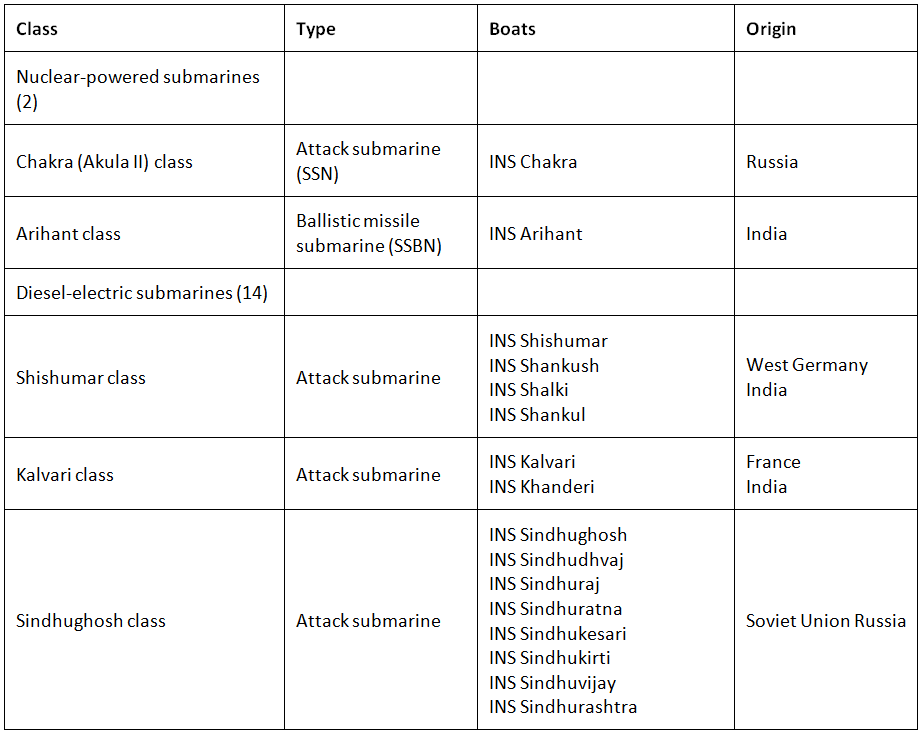
Planned
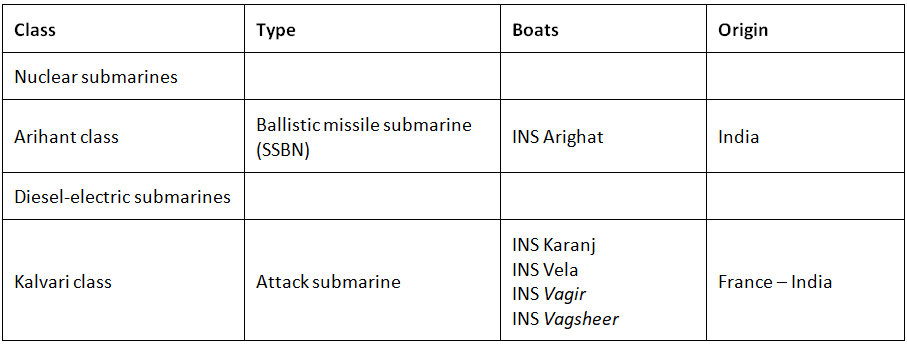
Ramjet engine vs Scramjet engine
- A jet engine is a mechanical device that converts the energy stored in liquid fuel into a powerful forward thrust, which propels an aircraft. This thrust is generated by expelling a high-speed stream of exhaust gases produced by the combustion of fuel.
- A ramjet engine is a type of air-breathing jet engine that operates by using the forward motion of the vehicle to compress incoming air for combustion. Unlike traditional jet engines, ramjets do not have a rotating compressor to compress air. Instead, the motion of the vehicle itself forces air into the engine, where it mixes with fuel and ignites to produce thrust. Ramjets are most efficient at supersonic speeds, typically around Mach 3 to Mach 6, but their efficiency decreases at hypersonic speeds.
- A scramjet engine, short for Supersonic Combustion Ramjet, is an advancement over the ramjet engine. It is designed to operate efficiently at hypersonic speeds and allows for supersonic combustion. Scramjets are capable of operating at extremely high speeds, making them suitable for hypersonic flight. They also rely on the vehicle's forward motion to compress air, similar to ramjets, but they are optimized for higher-speed flight.
- An air-breathing propulsion system uses hydrogen as fuel and extracts oxygen from the atmosphere for combustion. This system is designed to operate in the air-breathing mode and is often associated with scramjet engines, which utilize atmospheric oxygen for combustion rather than carrying an oxidizer onboard. This approach can reduce the weight and complexity of the propulsion system for high-speed flight.
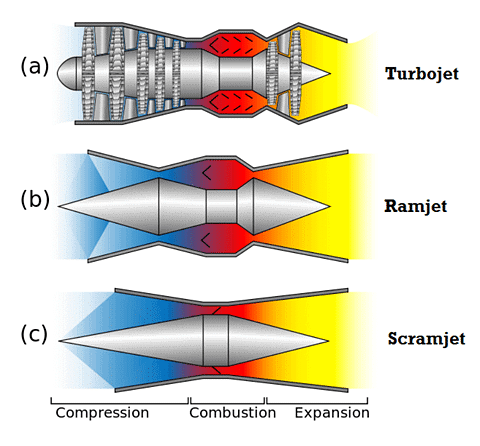
Unmanned aerial vehicles
Drones, also known as unmanned aerial vehicles (UAVs), are aircraft that operate without a human pilot onboard. They can be controlled remotely by human operators on the ground or operate autonomously based on pre-programmed instructions.
Drones serve various purposes and can be broadly categorized into two main types:
- Reconnaissance and Surveillance Drones: These drones are primarily used for collecting visual or data intelligence. They are equipped with cameras, sensors, and other equipment to gather information about a particular area, object, or situation. Reconnaissance drones are valuable for military and civilian applications where real-time information is essential.
- Armed Drones: Armed drones are equipped with missiles, bombs, or other weaponry and are capable of carrying out offensive operations. They can engage targets, conduct airstrikes, or perform other combat-related missions. Armed drones are often used in military scenarios for precision strikes and combat support.
Drones can further be classified into the following functional categories:
- Target and Decoy Drones: These drones are designed to mimic enemy aircraft or missiles, providing target practice for ground and aerial gunnery exercises.
- Reconnaissance Drones: Reconnaissance drones are deployed to gather intelligence and provide critical battlefield information to military forces.
- Combat Drones: Also known as Unmanned Combat Air Vehicles (UCAVs), combat drones are equipped with weapons and are capable of carrying out high-risk combat missions. They are used for airstrikes, close air support, and offensive operations.
- Logistics Drones: Logistics drones are specifically designed for transporting cargo and materials. They are used in various industries, including logistics, supply chain management, and disaster relief.
- Research and Development Drones: These drones are used for testing and advancing UAV technologies. They serve as platforms for developing and integrating new technologies into operational UAVs.
- Civil and Commercial UAVs: Civil and commercial drones are designed for non-military applications. They are used in industries such as agriculture, filmmaking, surveillance, search and rescue, and environmental monitoring.
While these categories cover a wide range of drone applications, modern drones are increasingly designed to be versatile and capable of performing multiple roles, blurring the lines between these functional categories.
UAV of India
Nishant
Nishant is a multi mission Unmanned Aerial Vehicle with Day/Night capability used for battlefield surveillance and reconnaissance, target tracking & localization, and artillery fire correction.
Rustom
Rustom (Warrior) is a Medium Altitude Long Endurance unmanned combat air vehicle (UCAV) being developed by the Defence Research and Development Organisation.
- The design for Rustom UAV has been derived from National Aerospace Laboratories’ light canard research aircraft developed under the leadership of late Prof Rustom Damania.
- It will replace the Heron UAVs of the Indian armed forces.
- Rustom UAV will be able to enter 250 km inside the enemy territory and can carry a variety of cameras and radars for surveillance.
- Rustom-H variant is a multi altitude long endurance UAV that has a twin-engine for carrying out surveillance and reconnaissance missions. It will have a payload capacity of 350 kg.
Variants of Rustom
- Rustom I tactical unmanned aerial vehicle with the endurance of 12 hours. The design of Rustom I will be based on National Aerospace Laboratories’ LCRA.
- Rustom H will be a larger unmanned aerial vehicle having a flight endurance of more than 24 hours. The design will be different from Rustom I and will have a comparatively higher range and service ceiling
- Rustom II will be an unmanned combat aircraft based on the Rustom H model.
UAV Panchi
It is the wheeled version of unmanned aerial vehicle (UAV) Nishant, capable of taking-off and landing by using small airstrips. Panchi UAV has autonomous flight capabilities and is controlled from a user friendly Ground Control Station (GCS).
Recent Developments
1. Hypersonic & Next-Gen Missiles
ET‑LDHCM (Extended Trajectory–Long Duration Hypersonic Cruise Missile): Successfully tested in July 2025 at Mach 8, with a strike range of 1,500 km, marking a major leap from BrahMos capabilities.
Part of Project Vishnu, DRDO is developing 12 hypersonic missile variants, including glide vehicles and hypersonic cruise missiles.
2. Short-Range Ballistic Missile – BM-04
In March 2025, DRDO unveiled the BM‑04 SRBM, capable of hypersonic speeds (Mach 5+), with a range of 400–1,500 km, featuring precision navigation via NavIC/GPS.
3. Submarine-Launched Ballistic Missiles (SLBMs)
K‑5 SLBM: Development completed in mid‑2025, boasting a range of 5,000–6,000 km; it's expected to expand India’s underwater strategic strike reach.
K‑6 SLBM: Under development for 8,000 km range, designed for future S5-class submarines; testing is underway.
4. Expanded Missile Exports & Procurement
Following Operation Sindoor, India gained attention for its indigenous systems (e.g., BrahMos, Akash, Pinaka) and is targeting a jump in defense exports—from ₹23,000 crore to ₹50,000 crore annually.
The Defence Ministry approved 87 armed heavy-duty MALE drones and over 110 air-launched BrahMos missiles under a ₹67,000 crore modernization package in August 2025.
5. Operational Showcases
During Operation Sindoor, BrahMos and Akash missiles executed precision strikes with under one-meter accuracy, underscoring the effectiveness of India’s missile range and system readiness.
|
90 videos|491 docs|209 tests
|
FAQs on Defence Technology – Missiles, Submarines, UAVs - Science & Technology for UPSC CSE
| 1. What are the primary differences between ballistic missiles and cruise missiles? |  |
| 2. What are the key features of India's Prithvi missile system? |  |
| 3. How do Agni missiles contribute to India's strategic defense? |  |
| 4. What is the significance of the Integrated Guided Missile Development Program (IGMDP) in India's defense strategy? |  |
| 5. What role do Quick Reaction Surface-to-Air Missiles (QRSAM) play in India's air defense strategy? |  |
















